

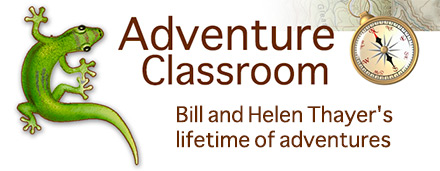
DEATH VALLEY NATIONAL PARK
Unless otherwise noted, photos (c) Helen Thayer
Death Valley is a wild, remote and challenging region that includes the lowest point in the USA at 282 feet below sea level and the hottest temperature ever recorded in the Western Hemisphere at 134 degrees. Ninety-six degrees, was the highest temperature I experienced in my visit, a bit hotter than normal for November.
Learn More About Death Valley [Page Two]
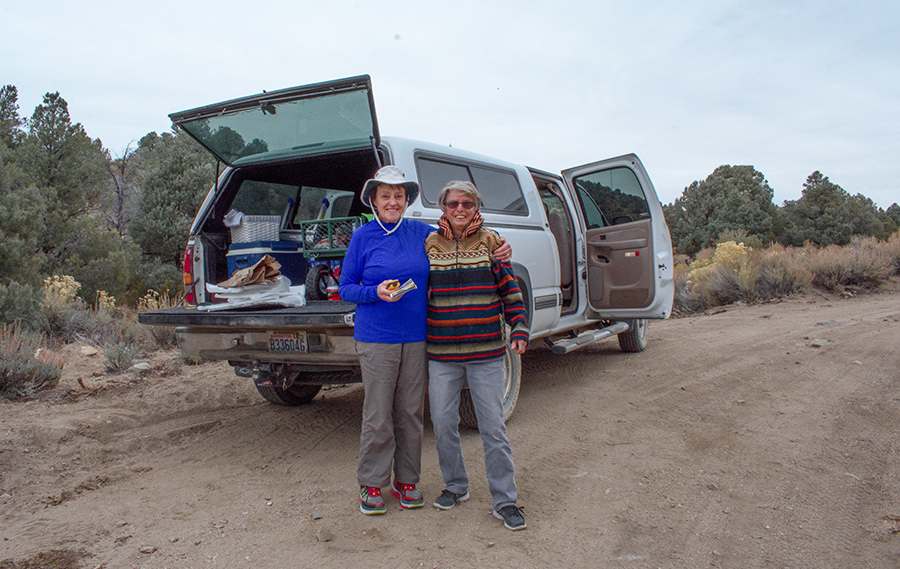
Helen and Thea
I trekked the full length of Death Valley from its most northerly point at the official marker where the Nevada state line and the northern Death Valley border intersect to the extreme southern border at the Harry Wade Monument.
I began on my 80th birthday, November 12th 2017. I traveled alone, pulling my supplies and water behind me in a four wheeled cart I called "Molly." Wherever I went, Molly followed. The 225-mile route I followed took thirteen days and maneuvered me over mountains and rough backcountry terrain but revealed to me some amazing vegetation and obscure geology and landscapes.
I began the journey at an elevation of 6,270 feet at the park's northern border, then followed the Cucomungo Canyon that descends to the Eureka Plains, an elevation drop of 3,000 feet in fifteen miles.
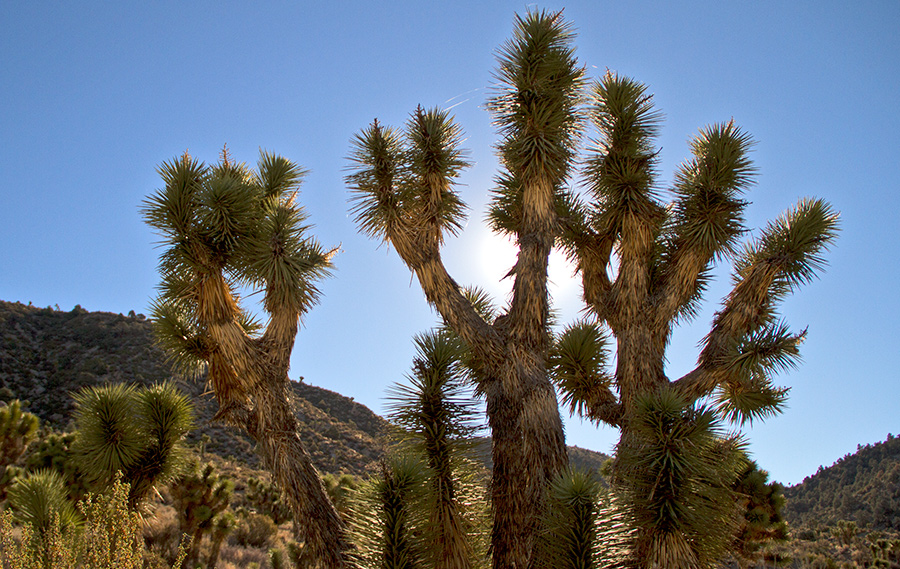
Joshua Trees at higher elevation
The first day took me through a spectacular region dominated by the other-worldly looking Joshua trees that prosper at the higher elevation. There were deep mountain washes that showed evidence of the intense mountain rain storms that send destructive torrents of water racing down the mountainsides and into the valley below.
The next day I began to climb the Last Chance Mountains which I had to get over in order to reach the main part of Death Valley. Upward I trekked, pulling my cart of supplies and water. Now and then a tarantula crossed my path seemingly with no particular interest in this strange human that pressed on step after step through their homeland. I climbed through Hanging Rock Canyon; well named for the spectacular colored rock cliffs that now and then sent loose rocks cascading in my direction. After many hours of hard pulling I reached an abandoned sulfur mine that heralded its presence by its distinctive "rotten egg" odor long before I arrived. Repulsive odor or not, I was happy to at last reach the mine as it occupies the summit of 5,200 feet - no more climbing for a while. Next came the rough gravel, knee jarring decent in a race to reach the fabled Crankshaft Junction before nightfall. Crankshaft Crossion is an odd place with several ancient, rusting engine crankshafts lying about and used as signposts. No doubt someone had encountered serious engine trouble here and their discarded ironware had started some sort of tradition.
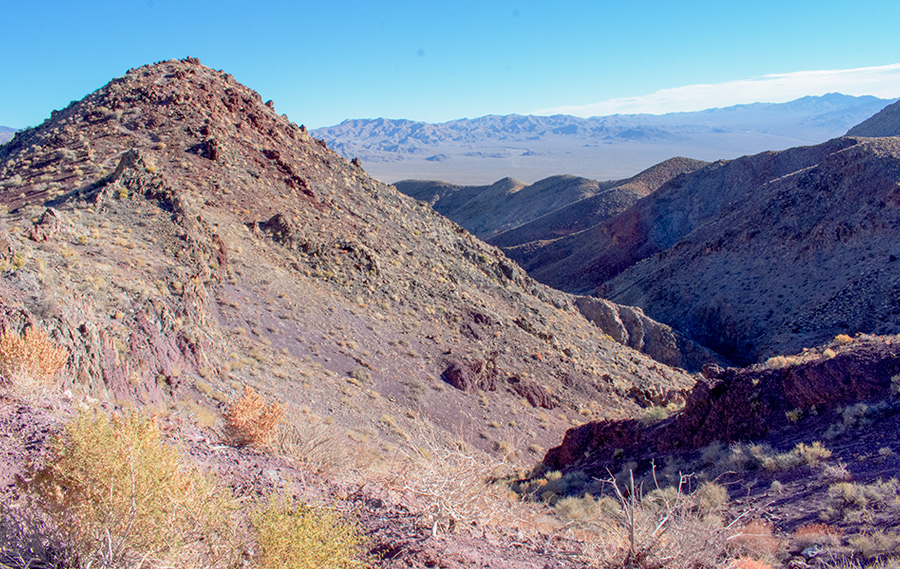
Rugged terrain overlooks the valley
From the Junction I turned south and headed down the main valley. I weaved back and forth trying to find the easiest route for Molly whose wheels did not find easy passage through the rocks, holes and deep gravel. That night after clearing away rocks, I found a reasonably smooth place to erect my tent. After a quick no-cook meal of freeze-dried meat and vegetables I was very relieved and had no trouble sleeping the night away.
Daybreak crept over the landscape at 6AM. Time to pack and start another day. I headed into a golden sunrise that lifted my spirits and quickened my steps. Another 15-mile day passed and as the sun set in streaks of red across the wide sky I set up camp, this time amid clusters of barrel cactus. It must have been about 3AM when I was awakened by something that moved Molly parked right beside my tent door. I jerked upright and to my astonishment I was looking into the eyes of a large coyote not more than two feet away, standing by Molly. I don't know who got the biggest surprise because my large, furry visitor bolted away with lightening speed, while I sat there somewhat startled by the encounter. However I knew that this fellow must have been curious and was only investigating his new neighbor and meant no harm.
On night number five I awoke about midnight feeling nauseous. I hoped it would be temporary and I would recover by morning. But that wasn't the case. At daybreak I was vomiting and feeling weak. I delayed my day's start hoping I could shake off whatever it was. At 10 AM I set out hoping that this didn't mean the end to my trek. An hour later I stopped and from my first aid kit I took out the thermometer to check my temperature. It was no comfort to read 104 degrees. No wonder I was weak, and inclined to bouts of light-headiness. I realized that the time had come to decide whether to continue or wait for help. I was sitting on a large rock at the side of a rutted, potholed gravel trail that passed for a 4X4 vehicle road when an SUV, trailing an enormous cloud of dust, clattered to a stop when the occupants saw that I was in obvious trouble. They were a doctor and his wife out exploring the wilds of Death Valley. He immediately took my temperature. Once more the thermometer read 104. The doctor's diagnosis was food poisoning. These kind and concerned people wanted to turn back and take me to a hospital in a nearby town. However I knew that if I stopped and even temporarily left the Park for medical help I might not re-start my trek again. I knew deep down that if I could put one foot in front of the other and focus on the positive I could fight my way through this. After convincing the doctor that I was determined to work my way through my dilemma, he and his wife reluctantly left with the promise that they would check on me next day on their way out. It was determined that my daytime food bars had gone bad and had caused the problem.
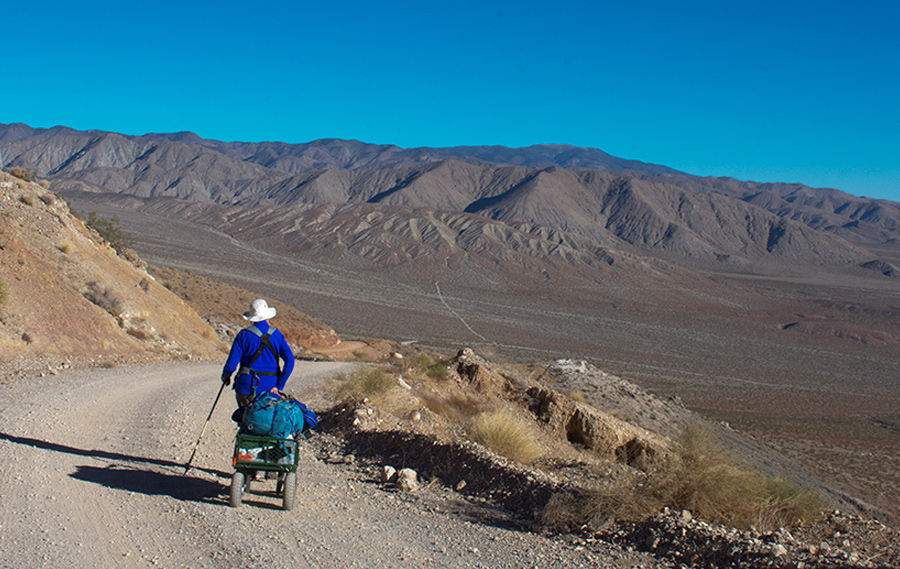
Helen and Molly
Eating was out of the question; whenever I was overwhelmed with weakness and dizziness I stopped to regain my equilibrium. The day's travel yielded only four hard won miles but at least I was still making progress even though my body was protesting. It was my determination, experience and above all my mind set that one step at a time would get me through that kept me going.
Next day I realized that I had entered the debit side of dehydration that I knew was dangerous in a place like Death Valley where the humidity is very low resulting in the need to drink a lot of fluids. The doctor stopped by on his return journey and was pleased to find that I was gradually improving, but warned that because I was continuing to exert myself it would take longer to recover. Even with this warning he understood my determination and he and his wife wished me good luck and disappeared in a billowing cloud of dust.
My base-camp and my friend Thea were at the Stovepipe settlement in the approximate center of the Valley. She brought me replacement day-food so that I could nibble a little at a time. Over the next four days my temperature dropped to normal, my stomach stopped complaining and my strength gradually returned. It was a tough fight but I was winning the battle; although the food poisoning had reduced my daily mileage, I was making progress.
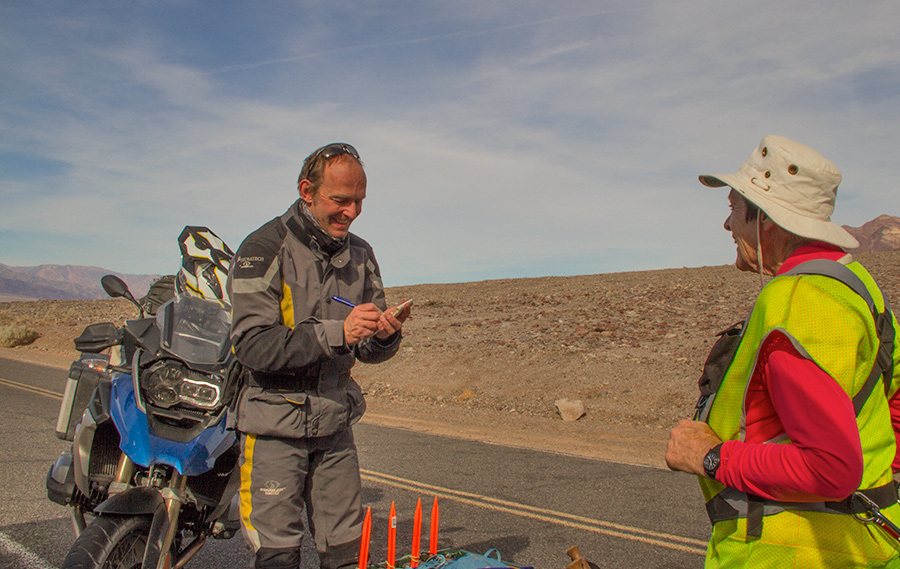
Speeding ticket?
At one point, several days into the trek, I was forced to travel part of the highway because my illness made it impossible to pull Molly through the rocky terrain. This was a new experience. Never in all my past worldwide treks had my husband and I ever walked on a paved road and had never encountered vacationers who in this case were visiting Death Valley. And I have to say it was a lot of fun. The most often asked question was, "Why are you doing this?" Their look of amazement was priceless when I told them that I was celebrating my 80th birthday. Without fail there would be a moment or two of silence while they absorbed the fact that an 80-year-old woman would ever undertake such an adventure.
One man stopped in his pickup truck and wanted to make me a sandwich so he told me, "that I can say I was part of your trek." Two young women stopped and ran back to me with bottles of water. Others stopped and offered candy bars and many just wanted a photo and conversation. Two women talked about their recent loss of husbands and compared notes with me on how we all have to handle such loss. One man gave me a reflective jacket; "To make you more visible while on the pavement."

The main valley is very flat
One afternoon as the sun disappeared over the mountains a Highway Patrol car approached. My first thought was, "Oops am I doing something wrong?" I knew I certainly wasn't exceeding the speed limit that had read 45 miles per hour on the last sign. But no worries. He was Robert, a Patrolman with an up-beat personality who was obviously meant to be in law enforcement. His cheery enquiry, "is everything alright?" began a long conversation and eventually a friendship with he and his wife and family. All in all I decided that there are a lot of good people in this world and Death Valley was a good place to meet them and make new friends.
Eventually it was time to leave the pavement and travel the Harry Wade route that would lead me to the finish 26 miles away. The remaining walk would be through rough holes and ridges, soft sand, deep loose gravel and accompanied by the dust. It was a challenge to pull Molly through and make good mileage, but I had to make up for time lost.
One afternoon as I pushed hard for more mileage I stopped for a drink when I noticed a little fly sitting on a mesquite branch. I watched, fascinated to see something alive and moving. I even talked to it as it moved along the branches. When he suddenly flew away I felt intense disappointment. It was as though I had lost a friend. I stood for some time thinking about it all and I realized that we humans do like company. In the absence of any sound or the sight of another living creature, a fly will do. Later I stopped to watch a gecko that sat motionless. I bent down and touched him; another friend. I continued onward and it was quite some time before I stopped thinking about my two new friends.

Many different landscapes in the park
Finally the day arrived to finish the trek; only six miles to go. I longed to see the Harry Wade Monument that stood at the southern border. That night I hardly slept. I just wanted to get out there and get it done. Finally daylight crept in and as soon as I could see the way ahead I left. The last three miles were the worst yet. The gravel looked as if they had tried to plough it. But finally I could see in the far distance cars speeding along the adjacent highway. The end was close. More deep gravel and sand and ups and downs. Then there was the Monument just ahead. It was Saturday 10: 40 AM, 13 days after I began the trek. The food poisoning had drastically slowed my progress and added several days to the journey, but I had overcome adversity and it was done.
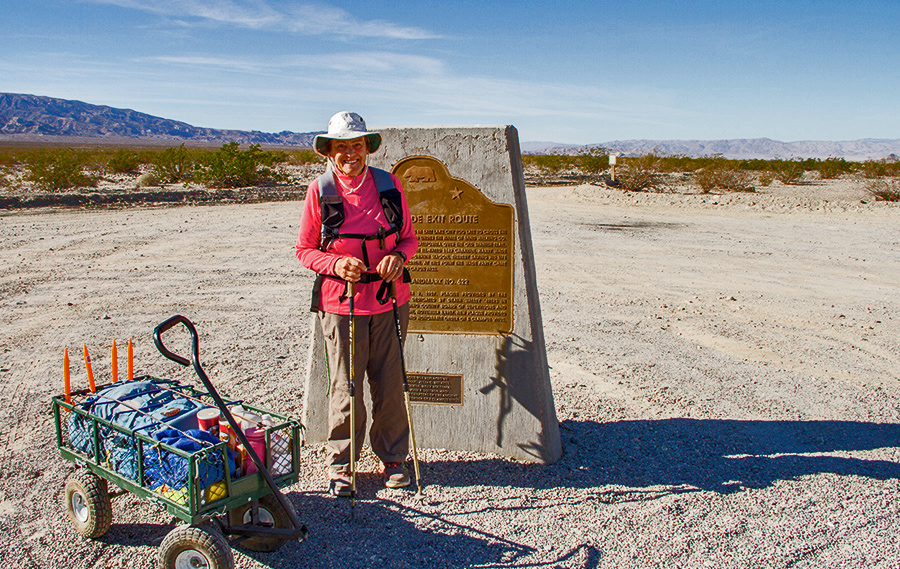
Helen at the finish marker
As always on these long treks, I learned more about myself and about the amazing environment that surrounded me. However the greatest reward was my interaction with people who were inspired by my journey, leading me to observe and believe that my trek made a positive difference in other people's lives.
My thanks to my faithful and cheery friend Thea, who was in charge of my base camp. Her help was invaluable. I also thank the many people who helped me through the loss of my husband, Bill, and nine months later, my mother. Bill and I used Death Valley to train and prepare for our Sahara and Gobi desert treks. Wanting to preserve Bill's legacy, I made the Death Valley trek in his memory and I will dedicate "Exploring America's National Parks" to Bill.
The next year at 81 years of age, I returned to trek Death Valley, this time with my new canine hiking partner Sam. Over the next several years we will hike and explore other National Parks together to gather material for Adventure Classroom.
Learn More About Death Valley [Page Two]
Back to [National Parks Index]
